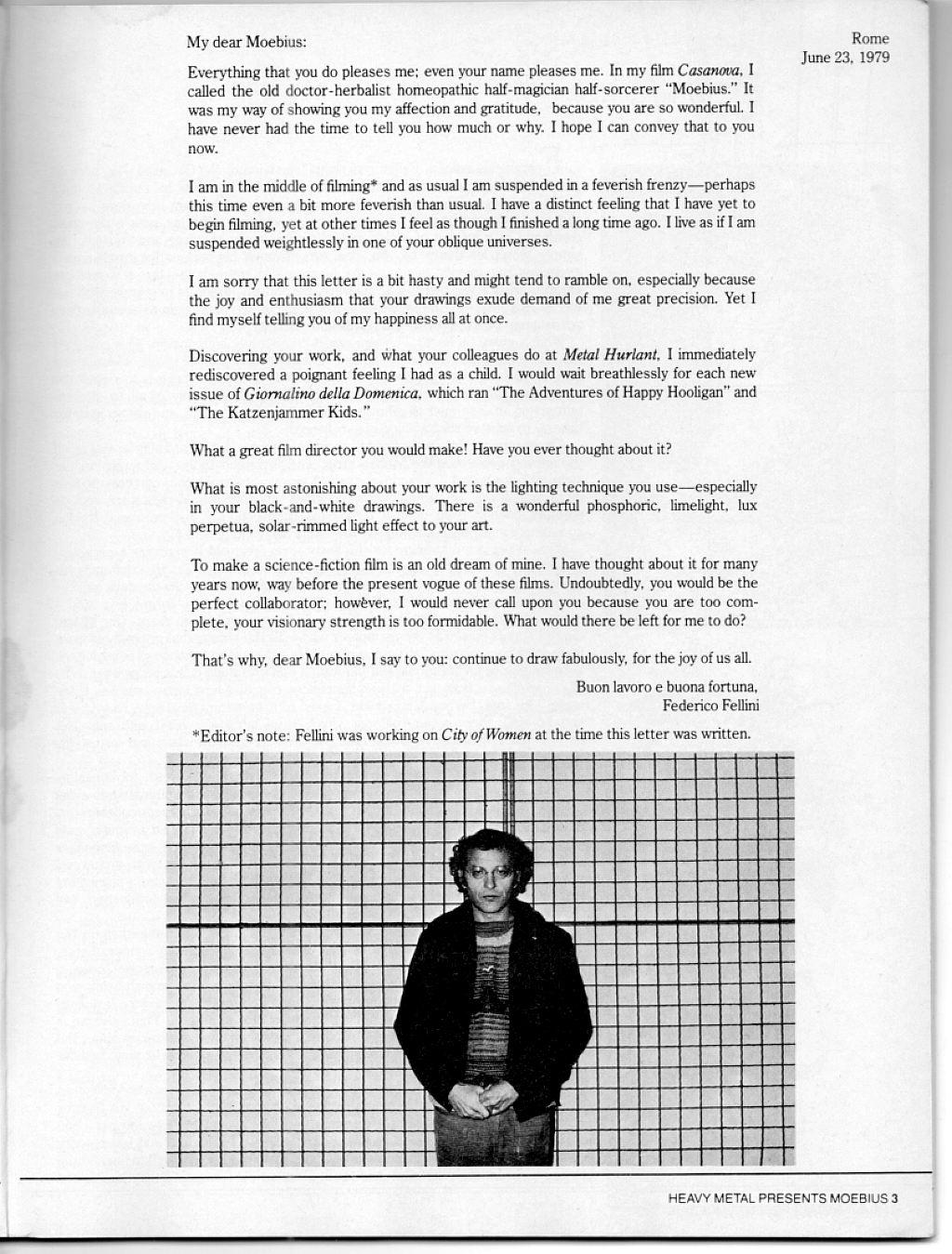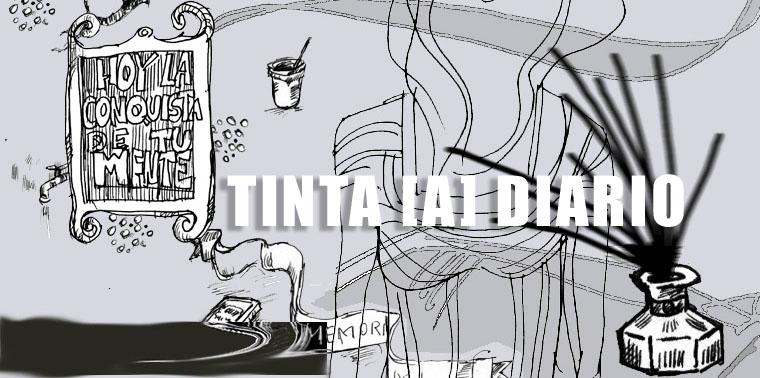La carta de Federico Fellini a Moebius
En 1981 la Revista Heavy Metal publicó un número dedicado a Moebius, la introducción fue una carta de Federico Fellini.
Arte Cultura y Entretenimiento | Redacción/ Escrito por Javier Martínez | Visit [a] TintaADiario en Facebook
En 1981 la Revista Heavy Metal publicó un número dedicado a Moebius, la introducción a esa publicación fue una carta de Federico Fellini pero además incluye un escrito de Brad Balfour, un editor invitado que luego fue editor asociado de la publicación de fantasía secuencial.
En la carta Fellini se deshace en elogios al artista, le indica que su trabajo y lo de otros artistas de Metal Hurlant ( Francés) lo retrotraen a la felicidad de la niñez, elogia sus dibujos en blanco y negro y habla de su deseo de realizar un film de ciencia ficción e invita a Moebius, pero después se retracta no porque no quisiera si no por otra razón importante,
La carta de Fellini es cálida y conmueve en su sencillez, pues nos demuestra la admiración de un maestro del cine, declarando una total fascinación a otro maestro, pero del arte secuencial tan cercano al séptimo arte.

by Alejandro Jodorowsky (Author), Jean Giraud (Illustrator)
La revista de 96 páginas fue lanzada en enero de 1981, incluye parcial la primera historia de lo que se convirtió luego en una historia extensa de varios libros, The black incal comienza la revista, y esta obra maestra de ciencia ficción de Moebius y Jodorowsky versa sobre las tribulaciones del detective John Difool mientras busca al precioso y codiciado Incal. John Difool, un detective de clase baja en un mundo distópico degenerado, encuentra su vida patas arriba cuando descubre un antiguo artefacto místico llamado «El Incal». Las aventuras de Difool lo pondrán en conflicto con el guerrero más grande de la galaxia, el Metabaron, y lo enfrentarán a los asombrosos poderes del Tecnopope. Estos encuentros y muchos más conforman una historia de proporciones cómicas y cósmicas en la que Difool lucha no sólo por su propia supervivencia, sino también por la supervivencia del universo entero.
Tambien se incluye algunas ilustraciones de Moebius para películas, se destaca la influencia de Mort Drucker, Will Elder y Harvey Kurtzman en estos ejemplos, incluyó ilustraciones para libros, un splash titulado Tom Smith rides again y Damnation Alley, a Science fiction chronicle. Se incluye una impactante historia de racismo titulada The White nightmare asi como tambien una historia variante acerca del lanzamiento nuclear titulada «one of 4,070 variations on the theme«. La parte final incluye la historia «A little bit of this and a little bit of that» , An adventure of John Watercolor, Wounded Knee, y una estilizada y detallada historia en blanco y negro llamada «The detour». La revista culmina con un historia de una página titulada «Afloat»

Carta de Federico Fellini a Jean Giraud – Moebius
Mi querido Moebius: Todo lo que haces me agrada: incluso tu nombre me agrada. En mi película Casanova, llamé «Moebius» al viejo médico-herbolario homeopático mitad mago mitad hechicero. Fue mi manera de mostrarte mi cariño y gratitud, porque eres tan maravilloso. Nunca he tenido tiempo de decirte cuánto o por qué. Espero poder trasmitirte eso ahora.
Estoy en medio del rodaje* y, como de costumbre, estoy suspendido en un frenesí febril, tal vez esta vez incluso un poco más febril de lo habitual. Tengo la clara sensación de que aún no he comenzado a filmar, pero en otras ocasiones siento que terminé hace mucho tiempo. Vivo como si estuviera suspendido ingrávido en uno de tus universos oblicuos.
Lamento que esta carta sea un poco apresurada y pueda tender a divagar, sobre todo porque la alegría y el entusiasmo que desprenden tus dibujos me exigen una gran precisión. Sin embargo, me encuentro hablándote de mi felicidad de una vez.
Descubriendo tu trabajo y lo que hacen tus compañeros en Metal Hurlant. Inmediatamente redescubrí un sentimiento conmovedor que tuve cuando era niño. Esperaría sin aliento cada nuevo número de Giornalino della Domenico. que transmitía «Las aventuras de Happy Hooligan» y «Los niños Katzenjammer».
¡Qué gran director de cine serías! ¿Alguna vez has pensado en ello?
Lo más sorprendente de tu trabajo es la técnica de iluminación que utilizas, especialmente en tus dibujos en blanco y negro. Hay un maravilloso protagonismo fosfórico. lux perpetua, efecto de luz con borde solar para tu arte.
Hacer una película de ciencia ficción es un viejo sueño que tengo. He pensado en ello durante muchos años, mucho antes de la moda actual de estas películas. Sin duda, serías el colaborador perfecto; sin embargo, nunca te llamaría porque eres demasiado completo, tu fuerza visionaria es demasiado formidable. ¿Qué me quedaría por hacer? Por eso, querido Moebius, te digo: sigue dibujando fabulosamente, para alegría de todos nosotros.
Buon lavoro e buona fortuna,
Federico Fellini
*Nota del editor: Fellini estaba trabajando en Ciudad de las Mujeres ( City of Women) en el momento en que se escribió esta carta.

In 1981 Heavy Metal Magazine published an issue dedicated to Moebius, the introduction to that publication was a letter from Federico Fellini but it also included a writing by Brad Balfour, a guest editor who was later associate editor of the sequential fantasy publication.
In the letter Fellini praises the artist, indicates that his work and that of other Metal Hurlant (French) artists take him back to the happiness of childhood, praises his black and white drawings and talks about his desire to make a science fiction film and invites Moebius, but later he retracts not because he didn’t want to but for another important reason,
Fellini’s letter is warm and moving in its simplicity, as it shows us the admiration of a master of cinema, declaring a total fascination for another master, but for sequential art so close to the seventh art.
The 96-page magazine was launched in January 1981, partially including the first story of what later became an extensive multi-book story, The Black Incal begins the magazine, and this science fiction masterpiece by Moebius and Jodorowsky covers about the travails of Detective John Difool as he searches for the precious and coveted Incal. John Difool, a low-class detective in a degenerate dystopian world, finds his life turned upside down when he discovers an ancient mystical artifact called «The Incal.» Difool’s adventures will bring him into conflict with the galaxy’s greatest warrior, the Metabaron, and pit him against the awesome powers of the Technopope. These encounters and many more make up a story of comic and cosmic proportions in which Difool fights not only for his own survival, but also for the survival of the entire universe.
It also includes some Moebius illustrations for films, the influence of Mort Drucker, Will Elder and Harvey Kurtzman is highlighted in these examples, it included illustrations for books, a splash titled Tom Smith rides again and Damnation Alley, a Science fiction chronicle. Included is a shocking story of racism titled The White Nightmare as well as a variant story about nuclear launch titled «one of 4,070 variations on the theme.» The final part includes the story «A little bit of this and a little bit of that», An adventure of John Watercolor, Wounded Knee, and a stylized and detailed black and white story called «The detour». The magazine culminates with a one-page story titled «Afloat»
Letter from Federico Fellini to Jean Giraud – Moebius
My dear Moebius: Everything that you do pleases me: even your name pleases me. In my film Casanova, I called the old doctor-herbalist homeopathic half-magician half-sorcerer «Moebius.» It was my way of showing you my affection and gratitude, because you are so wonderful. I have never had the time to tell you how much or why. I hope I can convey that to you now.
I am in the middle of filming* and as usual I am suspended in a feverish frenzy—perhaps this time even a bit more feverish than usual. I have a distinct feeling that I have yet to begin filming, yet at other times I feel as though I finished a long time ago. I live as if I am suspended weightlessly in one of your oblique universes.
I am sorry that this letter is a bit hasty and might tend to ramble on, especially because the joy and enthusiasm that your drawings exude demand of me great precision. Yet I find myself telling you of my happiness all at once.
Discovering your work, and what your colleagues do at Metal Hurlant. I immediately rediscovered a poignant feeling I had as a child. I would wait breathlessly for each new issue of Giornalino della Domenico. which ran «The Adventures of Happy Hooligan» and «The Katzenjammer Kids.»
What a great film director you would make! Have you ever thought about it?
What is most astonishing about your work is the lighting technique you use—especially in your black-and-white drawings. There is a wonderful phosphoric, limelight. lux perpetua, solar-rimmed light effect to your art.

To make a science-fiction film is an old dream of mine. I have thought about it for many years now, way before the present vogue of these films. Undoubtedly, you would be the perfect collaborator: however, I would never call upon you because you are too com-plete, your visionary strength is too formidable. What would there be left for me to do?
That’s why, dear Moebius, I say to you: continue to draw fabulously, for the joy of us all.
Buon lavoro e buona fortuna,
Federico Fellini
*Editor’s note: Fellini was working on City of Women at the time this letter was written.
Se pueden incluir imágenes de perfiles en Facebook, la red y otros medios. son utilizadas para ampliar la experiencia del lector. Javier Martínez es artista multidisciplinario de Puerto Rico






